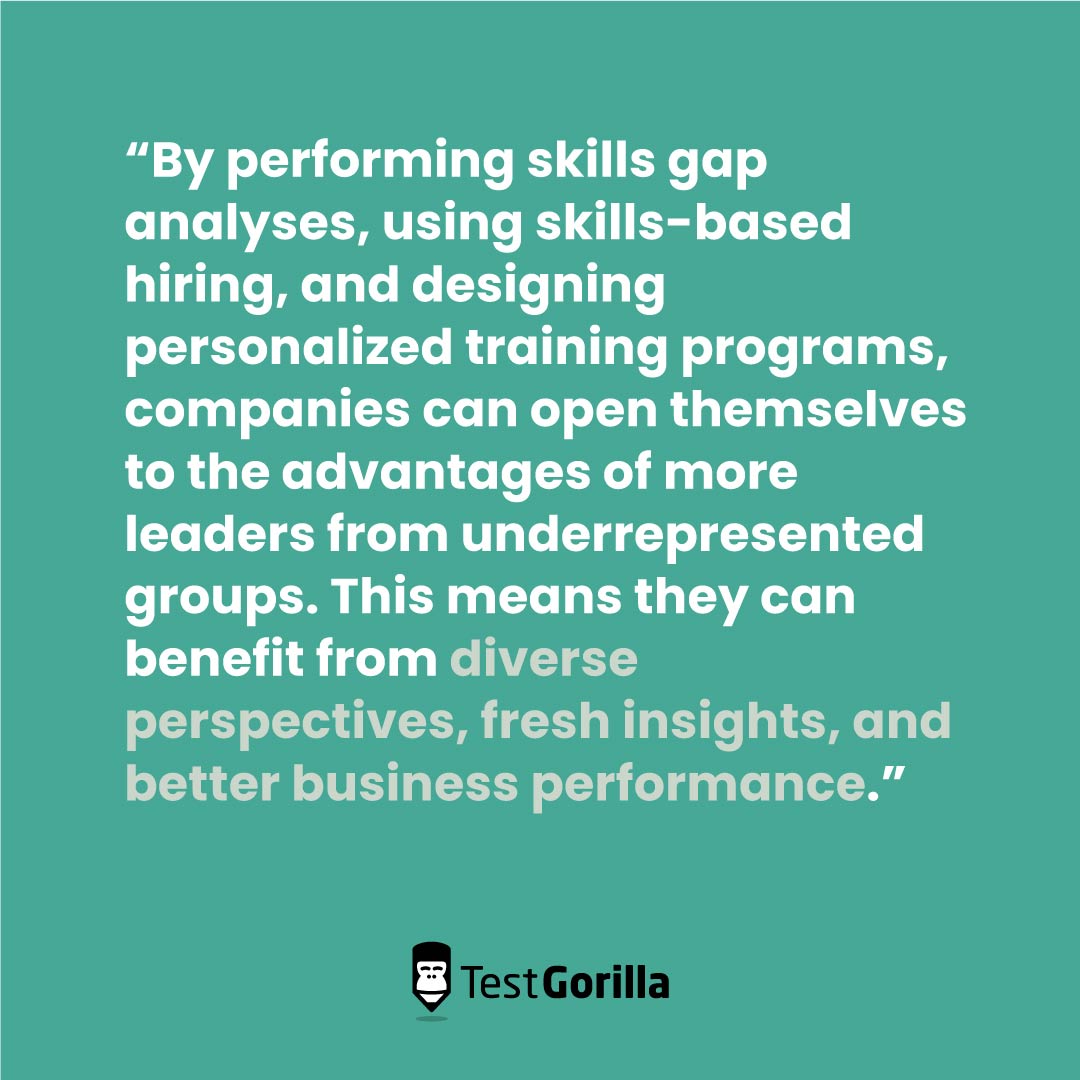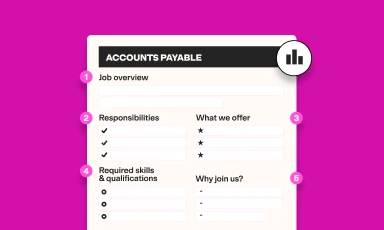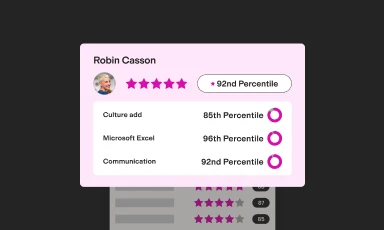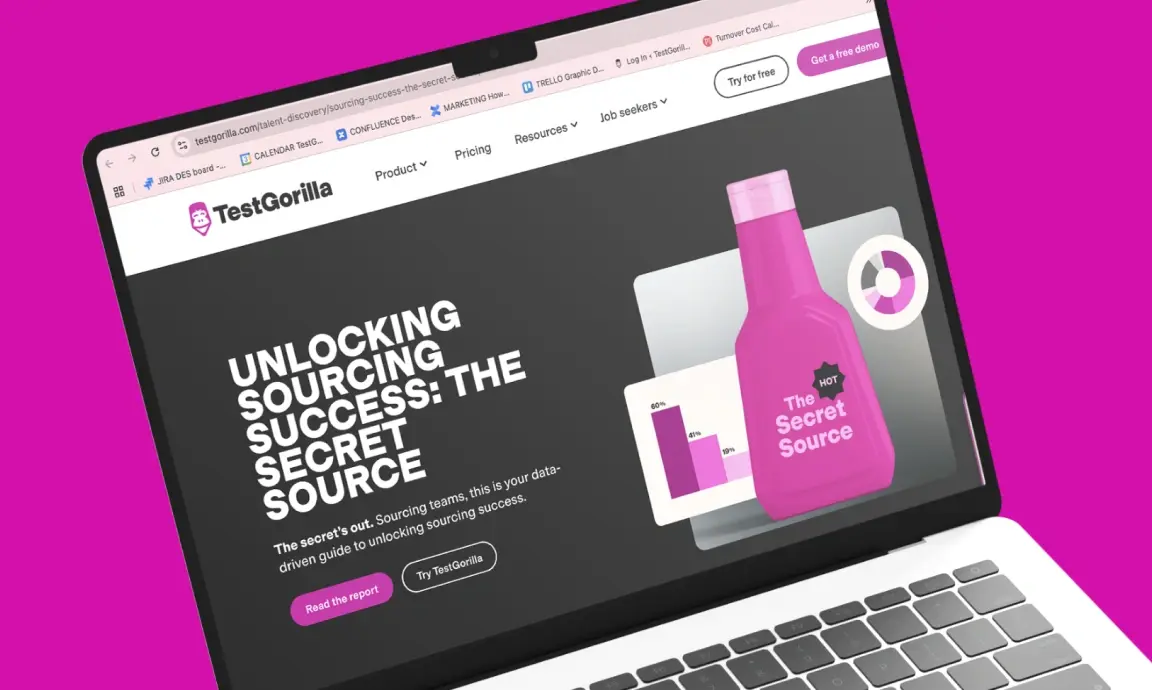Why developing leaders from underrepresented groups is good for business – and diversity
Diversity in leadership roles remains a critical, yet unmet, need in many organizations today. This issue isn’t about meeting quotas or being politically correct – it reflects a deeper problem that can hinder performance and stifle innovation.
An alarming number of companies could be missing out on insights, experiences, and perspectives that leaders from diverse backgrounds bring. These organizations aren’t adequately tapping into the rich pool of talent available in the broader community, limiting their potential growth and competitiveness.[1]
The cost of ignoring this problem is substantial. Studies have shown that diverse workforces outperform homogeneous ones, bringing fresh ideas and better solutions.[2] Yet when you look at executive boards and C-suites, they largely remain unreflective of the diversity within society.
Investing in diverse leadership development isn’t just the right thing to do – it’s a smart business strategy. Prioritizing diversity in leadership helps businesses unlock potential, drive innovation and stronger performance, and build more diverse teams – especially when employees from underrepresented groups can see themselves reflected in leadership.
This article will explore why developing leaders from underrepresented groups is essential for business success and diversity. We’ll also provide concrete steps that you can take to cultivate a more inclusive leadership culture within your organization.
How great leadership positively impacts your team
Great leadership shapes the culture of an organization in many ways. The behaviors demonstrated by leaders become the company’s cultural norms, far more than any stated values or motivational posters.
If you want to create an engaged team and make better business decisions, the focus should be on developing your leadership team.
In Google’s Aristotle project, psychological safety stood out as a crucial factor for high-performing teams. They found it’s about fostering an environment where everyone feels safe to speak up, express their thoughts, and take interpersonal risks such as admitting a mistake or suggesting an opportunity for innovation.
Psychological safety means we function best when we feel safe. This is when we allow the rational, creative part of our brain, the neocortex, to flourish without being hampered by panic responses from our limbic system and brain stem.
“When we don’t feel safe, we go into panic mode, and we start to shut down when somebody asks us a question.” - Ally Jones, co-founder of Coachable
To create such an environment, leaders must know how to foster psychological safety, coach effectively, handle tough conversations, and lead change.
Here’s the catch: unless they’re allowed to learn and develop these skills, they may not know they lack them.
That’s why leadership development is more than just an investment – it’s a necessity.
Why you should be developing leaders from underrepresented groups
If you’ve ever had to make an important call based on limited information, you’ll know what it’s like to commit to a choice you are only half confident in. This is what decision-making can be like for a leadership team that lacks diversity.
A diverse team offers a wider lens through which to view issues and solve problems, and can also better reflect the demographics of the customers you’re serving.
“If you’re targeting a product for mums looking to exchange baby clothes, and you’ve got a group of people in your leadership team that all work full time and don’t have children, there’s a real blocker there in terms of being able to understand the people you’re serving,” says Ally.
It’s also crucial to develop leaders from underrepresented groups, including women, BIPOC (Black, Indigenous, and People of Color), LGBTQ+ (lesbian, gay, bisexual, transgender, queer, and other sexual identities), and disabled individuals, among others. Only then will you have a truly inclusive and equitable workplace.
By ensuring diverse representation at leadership levels, organizations benefit from a broader range of perspectives and insights.
Research backs this up. For example, organizations in the top quartile with gender-diverse executive teams are 21% more likely to experience above-average profitability than their industry peers.[3] A more diverse company with a diverse leadership team is also better equipped to understand its customer base and workforce.
Diversity in leadership doesn’t just improve decision-making and financial performance – it also sets a strong precedent.
When employees from underrepresented groups see people like themselves in leadership roles, it sends a powerful message: “You belong here, and you can grow here.” This is empowering and inspiring and can boost employee engagement and motivation.
Why aren’t more underrepresented groups present in leadership teams?
We’re seeing more women, LGBTQ+, and BIPOC rising to leadership positions, yet the pace of change isn’t as quick as it could be.
Underrepresented groups face barriers to leadership due to societal norms and biases that perpetuate discrimination and unconscious biases based on factors like race, gender, ethnicity, sexual orientation, and disability.
For example, maternity and paternity leave policies globally heavily favor women, perpetuating the expectation that women shoulder the bulk of childcare. The impact of this became crystal clear during the Covid-19 pandemic, with women disproportionately taking on caregiving responsibilities.
A study by McKinsey also found that women in senior management were twice as likely as men in similar roles to spend “substantial time” on diversity, equity, and inclusion (DEI) work falling outside their normal job responsibilities, such as supporting employee resource groups (EGRs).
Combined with the demands of the C-suite, this adds to the overall pressure on women leaders and can affect their performance, perpetuating negative stereotypes about their ability to lead.
Attitudes toward career progression may also differ significantly between different groups and be self-limiting. For example, men are generally encouraged from a young age to speak up, take risks, and be ambitious. On the other hand, women are encouraged to be people pleasers, supportive of others, and to not “make a scene” by speaking up or standing out.
Even when attitudes and opportunities are equal, unconscious bias on the part of existing leadership or boards can hamper the ability of underrepresented groups to be promoted to leadership.
By helping underrepresented groups identify their strengths and realize their potential, organizations can inspire them to step up and pursue leadership roles. Then, they can reap the rewards of that enhanced decision-making potential.
However, achieving diversity takes creating a company culture that accommodates different needs and circumstances, such as by offering flexible work hours or remote work options. This is because individuals from underrepresented groups may face unique challenges and responsibilities that require flexibility and accommodations in the workplace.
A lack of inclusive policies and practices, like rigid work schedules or limited remote work options, can disproportionately affect these individuals, making it difficult to balance their personal and professional lives effectively.
The barriers to leadership for underrepresented groups are a tangled web of systemic, organizational, and personal factors. Tackling these requires change at multiple levels, but the payoff is worth it.
Let’s start by taking a look at how you can start developing a more diverse leadership team in your organization.
The best insights on HR and recruitment, delivered to your inbox.
Biweekly updates. No spam. Unsubscribe any time.
How companies can develop great leaders from all backgrounds
Creating a pipeline of effective leaders from all backgrounds isn’t without its challenges, but it’s achievable and benefits both employee engagement and business performance.
Let’s explore some actionable strategies you can use to champion diversity in leadership.
1. Get clear on what you need
Start by identifying the objectives of your program. Are you hoping to train first-time managers for promotion? Reduce time-to-market for products? Improve retention rates?
Establishing clear goals upfront will allow you to set relevant success metrics.
Ally recommends asking questions about your organization’s current direction and goals, leadership makeup, and leadership needs: “Ask where you’re going as a business. What is it you’re hoping to achieve as an organization and what leadership competencies, capabilities, and behaviors are needed to realize your long-term objectives?”
Remember, leadership training is about behavioral change, not just skills acquisition. Your leadership team may need to implement a range of styles, like transformational leadership, which focuses on inspiring and motivating employees, or democratic leadership, which involves making decisions collectively.
Successful leadership is also about knowing when to take the lead on decision-making and when to adopt a more consultative approach and trust your team’s expertise.
Consequently, you need tailored leadership programs that can have an impact specifically in response to your targets and strategies — not simply generic training courses with broad, unfocused aims.
2. Perform a skills gap analysis
The need for tailored leadership training is why Ally also suggests conducting a skills gap analysis. The findings can guide you in shaping your leadership development programs, which allows you to create a bespoke leadership journey for your executive team.
Skills such as empathy (which women tend to have), active listening, and the ability to ask thought-provoking questions are all essential for great leadership. These characteristics often align with a coaching style of leadership, which is effective because it encourages both personal development and team collaboration.
It’s interesting to note how outdated stereotypes – like the emotionless, ruthless CEO – are gradually being replaced by a more empathetic, understanding approach to leadership. Talent assessments like our Culture-add and 16-type personalities test can help identify and develop these skills within your team.
When you raise up leaders from underrepresented groups, you enable a broader range of leadership styles to come to the fore. This can positively impact company culture, employee engagement, and your bottom line.
3. Design a leadership development program
Once you’re clear on the competencies you need, you can start designing your program. Here’s an example roadmap:
Design your program. Your curriculum should be interactive, engaging, and, most importantly, result-oriented. It should foster empathy, active listening, confidence, and the ability to give constructive feedback.
Facilitate group environments. Group environments cultivate provocative thinking and problem-solving skills. You can do this by encouraging collaborative activities, providing mentorship opportunities, and hosting regular team meetings. This will help build an understanding of different perspectives while giving a platform for diverse voices to be heard.
Experiment with delivery methods. Shift from traditional classroom training to a more practical approach. Integrate live sessions, group coaching, and real-life scenarios to make the training more memorable and impactful.
Focus on implementation. Space out the sessions to allow leaders to digest and practice what they’ve learned. Continually monitor their progress and adjust the training as necessary. The key is to provide regular, bite-sized training sessions over a longer period, creating an environment for practice and muscle memory development. It’s a commitment, but one with a huge return on investment.
Encourage ongoing development. Leadership development doesn’t end with a program. Ensure there are ongoing opportunities for leaders to apply their new skills, receive feedback, and continue growing. This could be through additional training, mentoring, or real-world leadership opportunities. Implement skills-based hiring to find the right people for the role and level the playing field for diverse candidates when it comes to internal mobility.
Remember, an effective leadership development program doesn’t just equip leaders with skills. It fosters a culture of continuous learning and growth and helps retain and reward top talent.
4. Test, measure, gather feedback, and iterate
Once your program is underway, regularly gather feedback from the leaders-in-training, their peers, and their teams.
Ask pointed questions about the specific skills or behaviors you aim to develop, but bear in mind that change doesn’t happen overnight. Check-in periodically (six, nine, 12, or 18 months down the line) to measure the long-term impact of your program.
Tools like TestGorilla’s Leadership test are invaluable for assessing your leadership team and tracking improvement in their skills, behaviors, and decision-making over time. This test evaluates an individual’s ability to lead others, providing useful insight into their potential for growth within your organization.
Ultimately, leadership development is an ongoing process. Use your findings to continually refine your program, ensuring it remains relevant and effective.
5. Keep an eye on your data
Closely monitoring your leadership demographics can reveal systemic issues that might otherwise go unnoticed. If, for example, all of your leaders are white men, it’s a signal there might be hurdles during the hiring process, like unconscious bias or even defined policies and processes, that are holding back diversity and inclusion.
Review your hiring practices, promotion rates, and retention statistics and see where people are falling out of your leadership pipeline. Then, take the necessary steps to address any barriers they may be facing to promotion and success.
Promoting diversity in leadership isn’t just a box-ticking exercise. It’s an investment in the richness of ideas, perspectives, and experiences that drive innovation and better decision-making in your organization.
Diversity in leadership: Your competitive advantage and the right thing to do
From defining core leadership competencies to creating bespoke, behavior-focused development programs, proactively diversifying your leadership team is an investment in your organization’s people and culture.
However, championing diversity isn’t just a nod to the right thing to do, it’s a strategic imperative for businesses. It can improve decision-making, foster innovation, and give you a lasting competitive advantage. It takes more than a one-off initiative, though. Rather, it requires a thorough examination of any existing barriers and a commitment to positive change.
By performing skills gap analyses, using skills-based hiring, and designing personalized training programs, companies can open themselves to the advantages of more leaders from underrepresented groups. This means they can benefit from diverse perspectives, fresh insights, and better business performance.
Want to tap into more diverse leadership talent? Use skill-based hiring to build diverse leadership teams – and drive better business performance. Download the 2022 State of Skills-Based Hiring report to learn more |
Sources
“Labor force characteristics by race and ethnicity, 2021.” U.S. Bureau of Labor Statistics. Accessed June 12, 2023.
https://www.bls.gov/opub/reports/race-and-ethnicity/2021/home.htm
“State of Skills-based Hiring 2022.” TestGorilla.com. Accessed June 21, 2023.
https://www.testgorilla.com/state-of-skills-based-hiring-2022/
“Delivering through diversity, 2018.” McKinsey&Company. Accessed June 19, 2023. https://www.mckinsey.com/capabilities/people-and-organizational-performance/our-insights/delivering-through-diversity#/
Related posts
You've scrolled this far
Why not try TestGorilla for free, and see what happens when you put skills first.




















